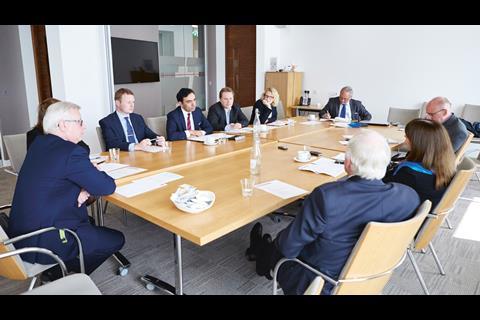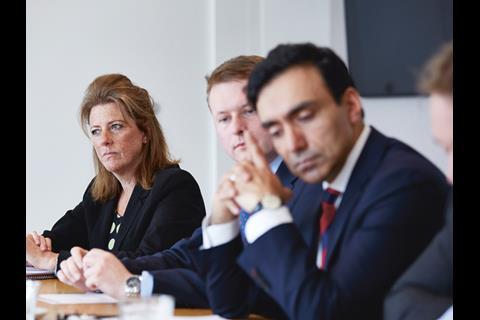The regeneration of Birmingham has turned around the fortunes of England’s second city as it seeks to position itself as a global player. What lessons does this hold for the lawyers involved? Jonathan Rayner reports from the latest Gazette roundtable.
In the 19th century, as Birmingham prospered, it was among the great manufacturing cities whose political and business leaders directed its wealth to gestures of civic grandeur and feats of engineering and infrastructure.
But much of the 20th century brought bad news for the city and its peers further north, as the economy moved away from the manufacturing base that had made it great.
Recent years have seen Birmingham’s fortunes turn again. With prestigious private and public projects, from a new library to train station rebuilds, grade 1 office space and parks, Birmingham’s centre looks very different from a decade ago. Lawyers have been deeply involved in this transformation: so the city is the ideal location for a Gazette roundtable on the role of law and lawyers in a regeneration that appears to be a resounding success.
The nine participants, including a major City firm partner and a non-lawyer town planner, were upbeat in their assessments of Birmingham’s future. Some talked about the ‘real renaissance’ in the city, others about the expanding airport, while others still pointed to the relocation of major banks and the thousands of jobs this has created.
They talked of Business Improvement Districts nd Local Enterprise Partnerships (LEPs), which bring the private and public sectors together to drive growth. The future is bright for Birmingham, they concluded, if there is ‘strong political leadership’ and if lawyers are allowed to help steer development projects from day one.
DWF insurance partner Derek Adamson, playing host at the firm’s One Snow Hill offices, introduced the first item on the agenda: strategic planning and the political context of regeneration. Birmingham, he says, with its revived civic buildings, infrastructure developments and multimillion-pound commercial investments, is a good case study for regeneration. Law firms, he adds, are not only advising on the process, but have themselves become major tenants in the heart of the city – DWF’s offices in the Snow Hill development zone are cheek by jowl with those of Pinsent Masons and Wragge Lawrence Graham.
Stuart Evans, lead planning and environment lawyer for Birmingham City Council, says the city’s regeneration has been assisted by the ‘continuity’ of the political party in power. ‘The present administration has now been in office for a number of years,’ he says, ‘and has been able to bring forward big schemes by giving a strong political lead. Such leadership is crucial and an essential part of working in partnership with LEPs throughout the West Midlands.’
Alan Greenough, former global head of private equity at Hogan Lovells and now in charge of the firm’s legal services centre in Birmingham, explains that the firm was looking for a base outside London where it could ‘do certain work cheaper’. He continues: ‘Birmingham won for us because of its proximity to London, the strength of its legal centre – we’re recruiting lawyers from scratch – and its rail and road links. There’s an airport, too, which finally did it for us. So I think [in addition to] what’s going on in the public sector and politically, other organisations, such as Deutsche Bank and HSBC, must have gone through a similar rationale to us and decided: “Yes, we’re going to go to Birmingham”.’
The key is to persuade all interested stakeholders to see a lawyer as an integral part of the team. My most successful projects are those where I have informed clients who bring in a lawyer as part of their team — Helen Garthwaite, Wedlake Bell
Greenough is asked whether the high-speed train line HS2 influences the firm’s decision-making. ‘Quite honestly, [HS2] won’t make much difference to us,’ he replies. ‘A London partner can be up and down to Birmingham in a morning already, so a half-hour saved is not going to make a huge difference. But for the city and the region, [HS2] is obviously an absolute imperative.’
DWF real estate partner Melanie Williams says: ‘HS2 may not make a difference for London, but in terms of Birmingham’s presentation as a global city operating in a global market it’s really important. It’s our moment of change, isn’t it? We’re no longer saying: “We’re just Birmingham”. We’re now saying: “We operate nationally and internationally”. Hogan Lovells coming to the city is a good indication of that because it’s a global firm joining our market.’
Evans agrees: ‘The city is starting to take a global lead. The airport is expanding and we’re surrounded by superb countryside. Birmingham is a good place to be.’
National firm Freeths social housing partner Mushtaq Khan, who is also president of the 4,000-strong Birmingham Law Society, draws the table’s attention to an article published in the Economist last year. He says that it characterised Birmingham as a successful city reduced by ‘poor strategic decisions’ to a failing city in the 1950s and 1960s. ‘Politics has an all-important part to play in shaping the direction of travel for a city and region,’ Khan says. ‘Politics sets the scope in terms of positiveness and attracting business. There has to be a vision.’
Adamson moves the debate on to the challenge for lawyers of meeting the needs of partners in regeneration. DWF’s Williams says that collaboration between the public and private sectors is an important market for law firms, but that there is a real danger that firms will price themselves out of it.
‘There is a massive difference between how much our private clients will pay and how much our public sector clients will pay,’ she says. ‘We need to get the right balance in terms of pricing the work correctly because, after all, we need to deliver a profit. The problem is, a lot of public sector work is quite complicated. They are like exam questions, with a bit of everything thrown in. They need to be partner-led and can’t be left to someone who is three or four years’ qualified. So there is an element of loss leader to the work. It’s a very fine balance.’
Helen Garthwaite, construction partner at London firm Wedlake Bell, says that collaboration between the private and public sectors is incredibly complex. ‘It takes a vast range of parties to get a project through from beginning to end,’
Garthwaite observes. There are issues of strategic planning, the environment and investments from overseas, as well as delivering the end product, she says: ‘If everything is not joined up, a wheel can come off. I think there’s a high risk there, and that’s what costs the money. If you’re going through a major deal, orchestrating it, [the high risk is] where you’ve got somebody [central to the success of the project] who doesn’t visualise right from day one what is needed.
‘Quite often – and I speak here very much as a construction specialist – we’re brought into the game too late. The key is to persuade all interested stakeholders to see a lawyer as an integral part of the team. My most successful projects are those where I have informed clients who bring in a lawyer as part of their team. You are there at the table from the beginning. Those are the projects that get delivered effectively, quickly and sensibly within budget.’
Matthew Storer, principal associate in Eversheds’ real estate regeneration team, sees further complexity in the relationship between public and private sectors.
‘One of a lawyer’s key roles, in addition to bringing legal skills, is project management in conjunction with the client. Compulsory purchase order (CPO) planning, procurement, state aid and governance are all parts of an incredibly complex web of specialities. Only one ball needs to be dropped and there are serious consequences in terms of delay and cost. Getting lawyers involved early is absolutely critical. Otherwise, as so often happens, you get everyone halfway through a project and then find yourself trying to ‘retrofit’ and change the basic structures.’
Greenough says: ‘The only way to get in early is to be close to your client. Most clients won’t bring in lawyers until an agreement is signed because they don’t want to pay [if the project doesn’t go through]. You need to have a close relationship where clients know you won’t charge them every time they pick up the phone.’
He adds: ‘As a corporate lawyer, I see huge opportunities. If you’re acting for an Asian investor, for example, on a difficult long-term project, there is every opportunity to add value and make yourself his best friend all the way through. You’ve then probably got a client for life. We have had a couple of Asian companies looking at doing deals in the West Midlands. There’s been a real effort to get Asian money into Birmingham. That’s got to be a huge opportunity because they are going to run into all the issues that we’ve been talking about and they need us to see them through the transaction.’
At the table
Derek Adamson, DWF: Sarah Smith, Rapleys; Digby Morgan, Trowers & Hamlins; Mushtaq Khan, Freeths; Matthew Storer, Eversheds; Melanie Williams, DWF; Jonathan Rayner, Law Society Gazette; Stuart Evans, Birmingham City Council; Helen Garthwaite, Wedlake Bell; Alan Greenough, Hogan Lovells
Khan suggests that the way clients procure legal services can be an obstacle to lawyers getting in early on a transaction: ‘Clients, quite rightly, are trying to get value for money. But this can result in a procurement process that knows the price of everything and the value of nothing. That can be a very costly exercise. I know many instances where private and public sector clients have ended up paying too much because of the way they procured their legal services.’
Williams suggests that the problem of costing work lies with the inflexibility of the tendering process. ‘You are often given a one-page pricing schedule that you have to complete saying how much an hour you will bill for a partner and how much for an associate. There is no scope for saying we can offer something innovative, such as a rebate or discount, because those procuring the services are interested only in their pricing schedule and won’t even consider issues outside it.’
She adds: ‘The challenges are that we have to accept the framework in which we’re working and the fact that we are looking for blended rates that are economical within our parameters. In DWF’s case, that means using the strength of our resources. We have lots of offices and so can’t be blinkered as to location. We have to use the expertise across the firm and not reinvent the wheel. We have to be economical internally which, as it happens, forces us to adopt best practice.’
Garthwaite says that to a degree DWF’s way of working makes location irrelevant and fundamentally changes the profession’s traditional working practices.
She asks: ‘What of the future? Are we all really going to end up sitting in offices like these or are firms going to be more satellite in their attitude towards flexible working? Many people are already doing one or two days a week homeworking. Some are working just four days a week and commute up from somewhere like Cornwall. Is this just the beginning?’
Digby Morgan, Trowers & Hamlins’ Birmingham office lead for housing regeneration, comments on his firm’s progress since it came to the city in 2011. ‘We’ve started taking on trainees over the last year and have noticed that applicants for training contracts are no longer just people from Birmingham or people who went to university here. The city is increasingly being perceived as an attractive place to live and work. The professional services sector is growing organically and has reached that critical mass where HSBC and Deutsche Bank have come here.
‘I left law school in Nottingham, another Midlands city, 12 years ago and never considered staying there. Now that has all changed. I’ve seen a real sea change in the attitude of my colleagues in the London office to the work of the Birmingham office. There is much more respect for it now than there was before.’
Adamson moves the debate to the next item on the agenda: working within the framework of special powers.
Evans says: ‘My definition of special powers is probably compulsory purchase orders. Birmingham City Council has historically used CPOs in partnership with private practice, developers and limited companies. The next special power that comes to mind are the enterprise zones which are crucial to developing parts of the city and providing the flexibility to allow fledgling developments to move forward.’
Williams suggests an innovative scheme to help solve the housing shortage: ‘On top of CPOs and enterprise zones, there is the Business Premises Renovation Allowance (BPRA), which is a government capital allowance to encourage the regeneration of commercial and other non-residential buildings.
‘But could we not lobby the government to allow BPRA to be used for housing? It could close some market gaps, just as it has done for offices. The government could say “here’s an incentive that no one else is going to use” unless it’s brought forward by private investors who can get a tax benefit from putting their money into the regeneration of failing areas.’
Evans looks forward to the creation of a ‘combined authority’ for the West Midlands, a ‘novel creature’ made up of three LEPs and seven districts, the latter including Birmingham, the Black Country, Solihull and Coventry. ‘If a combined authority comes to fruition, there will be a super-mayor with CPO, transport and housing powers. Local leadership is the local way forward.’
Garthwaite cautions: ‘It is important to integrate the community, jobs and somewhere to live close to those jobs.’
Khan adds: ‘I think also it makes local politicians accountable.’
Garthwaite agrees: ‘With power comes responsibility and accountability. Governance is also needed. There is some lawyering to be done [on all these issues].’
Williams focuses on local projects, too, in particular ones that give start-ups legal advice and a steer without cost. ‘Business Improvement Districts are an excellent example of this,’ she says. ‘The boards are made up of people from all sorts of businesses, including law firms, and the help is given by us for free. It’s a responsibility, a legacy for the future generation.’
The discussion moves on to consultation, transparency and decision-making. Storer says the lawyer’s role is to facilitate ‘a clear and clean decision-making process for our clients’. Certainty is ‘key’ for the private sector, he asserts, which needs to know that it can invest and plan with confidence, with no risk of challenge later. He goes on to talk about ‘gentrification’ and the concern that one is going into existing communities and out-pricing the original residents.
He says: ‘The public have the right to hold the decision-making to account, and so if you want the regeneration to go through you must first consult with the public. After all, CPO-ing and demolition are life-changing events and can be traumatising if not done correctly. It is better by far to have the residents involved and fully supportive. It’s fantastic when they bang the drum for your proposal.’
Sarah Smith, from town planning consultancy Rapleys, says: ‘There is a big disconnect in the process. No matter how much we engage within a local area before regeneration, and no matter how much agreement there is to the general concept of the plan, the moment the planning application goes in the public are up in arms about it. You can have a complete reversal.’
Khan defends the ‘tough decisions’ that were made during the regeneration and slum clearances of the 1960s. ‘There were some incredibly impoverished areas. I’ve seen photographs and the city was almost Victorian, like something out of a Dickens novel. Tough decisions were made, but – as has been said – communication is key. Some areas of Birmingham benefited considerably.’
Adamson concludes: ‘What is interesting about this entire subject is that when we talk about regeneration and developing projects around the city, including finding the businesses to populate all these buildings, it ultimately comes down to this: the basic socio-economic need for homes for people to live in and for schools, hospitals and other broader public sector provisions. It’s fascinating and underlies the need to shape working partnerships to deliver projects.’
- This roundtable was kindly hosted by DWF































No comments yet